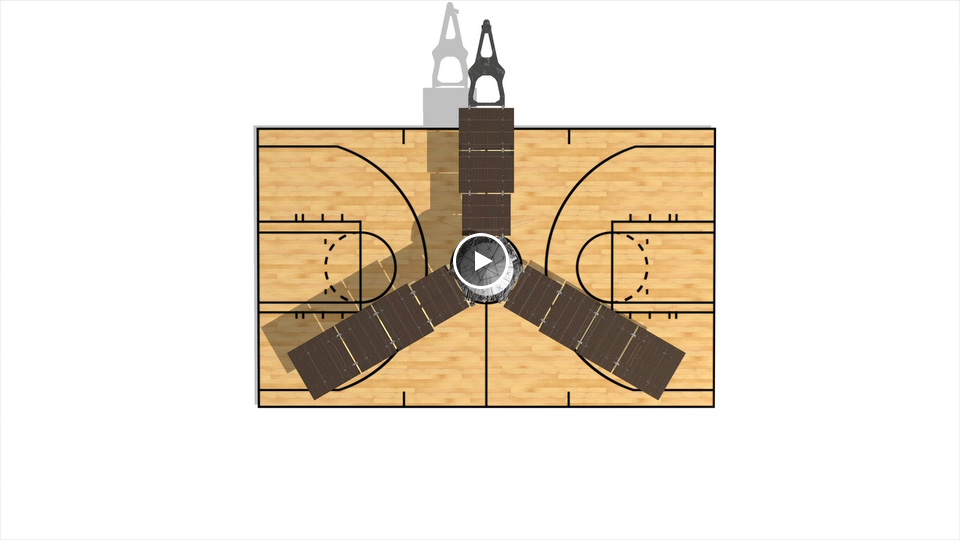Quick Facts
Click for more information
The Juno spacecraft will, for the first time, see below Jupiter’s dense cover of clouds. This is why the mission was named after the Roman goddess, who was Jupiter’s wife, and who could also see through clouds.
Dimensions: 11.5 feet (3.5 meters) high, 11.5 feet (3.5 meters) in diameter.
Solar Arrays: length of each solar array 29.5 feet (9 meters) by 8.7 feet (2.65 meters).
Total surface area of solar arrays: more than 650 feet (60 meters) squared.
Total number of individual solar cells: 18,698.
Total power output (Earth distance from sun): approximately 14 kilowatts; (Jupiter distance from sun): approximately 400 watts.
Weight: 7,992 pounds (3,625 kilograms) total at launch, consisting of 3,513 pounds (1,593 kilograms) of spacecraft, 2,821 pounds (1,280 kilograms) of fuel and 1,658 pounds (752 kilograms) of oxidizer.

This animation illustrates the relative size of the Juno spacecraft as compared to a regulation basketball court.
At the beginning of the Jupiter Orbit Insertion burn, Juno carries about 1,232 kilograms of fuel (810 kilograms of hydrazine and 422 kilograms of oxidizer). At the end of a nominal 35 minutes Jupiter Orbit Insertion burn, Juno will have burned about 447 kilograms of fuel (241 kilograms of hydrazine and 206 kilograms of oxidizer).
Type: Atlas V551 (Atlas first stage with five solid rocket boosters, Centaur upper stage)
Height with payload: 197 feet (60 meters)
Launch location: Pad SLC-41, Cape Canaveral Air Force Station, Florida
Mass of rocket (with spacecraft) fully fueled: 1,265,255 pounds (573,910 kilograms)

NASA's Juno spacecraft awaits launch from inside the payload fairing atop a United Launch Alliance Atlas V-551 launch vehicle. Juno and its rocket are at Space Launch Complex 41 on Cape Canaveral Air Force Station in Florida.
Launch date/time: August 5, 2011, 9:25 a.m. PDT (12:25 p.m. EDT)
Earth–Jupiter distance at time of launch: 445 million miles (716 million kilometers)
Time it took light to travel from Earth to Jupiter on Aug. 5, 2011: 39 minutes, 50 seconds
Earth gravity assist flyby: October 9, 2013
Distance Juno traveled launch to Earth gravity assist: 994 million miles (1,600 million kilometers)
Juno’s altitude over Earth’s surface at closest point during gravity assist: 311 miles (500 kilometers)
Jupiter arrival: July 4, 2016
The Jupiter Orbit Insertion (JOI) burn begins at 8:18 p.m. PDT (Earth Receive Time).
The burn is scheduled to end at 8:53 p.m. PDT (Earth Receive Time)
One-way speed-of-light time from Jupiter to Earth on July 4, 2016: 48 minutes, 19 seconds
Distance of Jupiter to Earth at time of Jupiter orbit insertion: 540 million miles (869 million kilometers)
Total distance traveled, launch to Jupiter orbit insertion: 1,740 million miles (2,800 million kilometers)
End of mission (deorbit): February 20, 2018
Distance traveled in orbit around Jupiter: 348 million miles (560 million kilometers)
Total distance, launch through Jupiter impact: 2,106 million miles (3,390 million kilometers)
The Juno mission investment is $1.13 billion in total. This cost includes spacecraft development, science instruments, launch services, mission operations, science data processing and relay support for 78 months.
A Mission of Many Firsts: